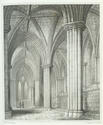 Pilgrimage might be undertaken to expiate sin, to pray for a particular purpose or to seek healing. Although there must have been pilgrims to Glasgow in the 12th century, the 13th century cathedral made access easier for them. It is assumed that the two offerings made by Edward I (1301) were at the tomb in the lower church and a shrine in the choir behind the high altar. Entry to the lower church was possible by doors to north and south: stairs at its west end allowed access to the ambulatory above from where the shrine could be viewed or visited without disturbing the canons’ services.
Pilgrimage might be undertaken to expiate sin, to pray for a particular purpose or to seek healing. Although there must have been pilgrims to Glasgow in the 12th century, the 13th century cathedral made access easier for them. It is assumed that the two offerings made by Edward I (1301) were at the tomb in the lower church and a shrine in the choir behind the high altar. Entry to the lower church was possible by doors to north and south: stairs at its west end allowed access to the ambulatory above from where the shrine could be viewed or visited without disturbing the canons’ services.
 The cathedral inventory (1433) lists jewels which decorated the shrine, probably removed because of a proposal to move the shrine following rearrangements after lightning damage to the cathedral. There were relics of St Kentigern, St Thenew and eight other saints: how and when these were displayed is unknown.
The cathedral inventory (1433) lists jewels which decorated the shrine, probably removed because of a proposal to move the shrine following rearrangements after lightning damage to the cathedral. There were relics of St Kentigern, St Thenew and eight other saints: how and when these were displayed is unknown.
In the Jubilee Year of 1450 the Pope granted an indulgence to all who, during four months in 1451, visited the cathedral, confessed before an approved confessor and offered one quarter of the cost of the journey to Rome on the high altar.
Another possible place of pilgrimage was St Thenew's chapel (containing her bones) and the associated well. When the well was cleared, several metal ex voto objects were found – models of parts of the body of pilgrims seeking, or giving thanks for, cures. The Protestant revolution (1560) effectively brought pilgrimage to an end.